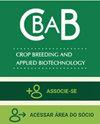Germplasm enhancement and cultivar development: The need for sustainable breeding
IF 1.1
4区 农林科学
Q2 Agricultural and Biological Sciences
引用次数: 3
Abstract
Abstract: Farmers need sustainable cultivars to increase food supply and value with less production land, animals, and inputs. Next generation plant and animal breeders face climate change adaptation and mitigation challenges. These challenges need to be addressed with opportunities for significant reduction of environmental impact developing cultivars less addicted to fertilizers and soil moisture needs. Sustainable breeding can help balance agriculture with the environment. Sustainable breeders need to integrate long-term pre-breeding activities with cultivar development efforts providing farmers options to comply with environmental regulations. Good choice of germplasm is still the most important decision. The most sophisticated tools will have limited success if poor choices of germplasm are made. Seed companies need capable breeders developing the next generation of sustainable cultivars while public institutions need to mentor sustainable breeders capable to not only broadening and improving unique germplasm but also developing new cultivars carrying desirable traits. Graduates mentored in breeding programs integrating these needs will be selected for industry jobs without need for re-training. Sustainable breeders will need to operate in new breeding centers located in strategic environments for faster genetic improvement ahead of climate changes. Key factors for developing useful and unique sustainable cultivars will be the adaptation of exotic germplasm and the maximization of its genetic improvement before cultivar development through public and private partnerships. Inbreeding, genetic divergence, and reciprocal recurrent selection programs will continue to be essential to purify cultivars and exploit heterosis in economically important species.种质改良和品种发展:可持续育种的需要
摘要:农民需要可持续发展的品种,以更少的生产用地、牲畜和投入增加粮食供应和价值。下一代植物和动物育种者面临适应和减缓气候变化的挑战。应对这些挑战需要有机会显著减少对环境的影响,发展对肥料和土壤水分需求较少的品种。可持续育种有助于平衡农业与环境。可持续育种者需要将长期的育种前活动与品种开发工作结合起来,为农民提供遵守环境法规的选择。优良的种质选择仍然是最重要的决定因素。如果种质选择不当,即使是最复杂的工具也只能取得有限的成功。种子公司需要有能力的育种人员开发下一代可持续品种,而公共机构需要指导可持续育种人员,不仅能够扩大和改进独特的种质,而且能够开发具有理想性状的新品种。在整合这些需求的育种项目中接受指导的毕业生将被选中从事工业工作,而不需要再培训。可持续育种者将需要在战略环境中的新育种中心开展工作,以便在气候变化之前更快地进行遗传改良。培育有用和独特的可持续品种的关键因素将是外来种质的适应和最大限度地进行遗传改良,然后通过公共和私人伙伴关系进行品种开发。近交、遗传分化和相互循环选择计划将继续是纯化栽培品种和利用经济上重要物种的杂种优势所必需的。
本文章由计算机程序翻译,如有差异,请以英文原文为准。
求助全文
约1分钟内获得全文
求助全文
来源期刊
CiteScore
2.40
自引率
13.30%
发文量
25
审稿时长
6-12 weeks
期刊介绍:
The CBAB – CROP BREEDING AND APPLIED BIOTECHNOLOGY (ISSN 1984-7033) – is the official quarterly journal of the Brazilian Society of Plant Breeding, abbreviated CROP BREED APPL BIOTECHNOL.
It publishes original scientific articles, which contribute to the scientific and technological development of plant breeding and agriculture. Articles should be to do with basic and applied research on improvement of perennial and annual plants, within the fields of genetics, conservation of germplasm, biotechnology, genomics, cytogenetics, experimental statistics, seeds, food quality, biotic and abiotic stress, and correlated areas. The article must be unpublished. Simultaneous submitting to another periodical is ruled out. Authors are held solely responsible for the opinions and ideas expressed, which do not necessarily reflect the view of the Editorial board. However, the Editorial board reserves the right to suggest or ask for any modifications required. The journal adopts the Ithenticate software for identification of plagiarism. Complete or partial reproduction of articles is permitted, provided the source is cited. All content of the journal, except where identified, is licensed under a Creative Commons attribution-type BY. All articles are published free of charge. This is an open access journal.

 求助内容:
求助内容: 应助结果提醒方式:
应助结果提醒方式:


